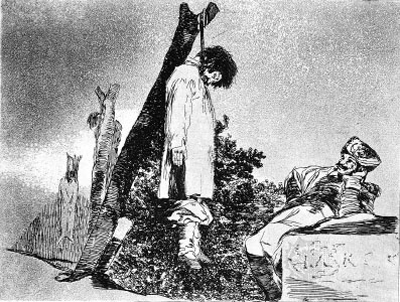
Here's "Verse 3", the next in a series of small collages that seem to be an irresistable byproduct of working on the Zero Sum Art Project. As with 1 & 2, Verse 3 is being sold on eBay, where you will find more information about how the image is put together and a detail of the collaged and painted surface.
Of course, "Verse 3" quotes an extremely famous photograph. There are three photographs that date from my early childhood that are indelibly burned into my mental image bank, this one being the street execution of a Viet Cong officer photographed by Eddie Adams in 1968.

Eddie Adams, 1968
As I was working with that collage, I started thinking about the lasting power of those 3 photographs from the Vietnam war. Though the subject matter is horrific, their strength is also that of the crafted image.

John Filo, 1970
There's a bunch of reasons why this photo by John Filo won a Pulitzer Prize, while

this one is relatively unknown, and the grieving figure of Mary Ann Vecchio is only one of them. It must be a terribly strange and awkward feeling to be witnessing a tragedy and on some level know that you just put together a fantastic image.

Huynh Cong "Nick" Ut, 1972
And the third image from that time that I can't escape, and that I no doubt share with many of you out there, is of course this one from 1972 of the terrified children escaping the napalm.
I've been thinking about how different those three photographs are from so much of the imagery we are seeing these days. Partly we have the dilemma of the journalists being embedded with the troops, and a much greater awareness by the military of the need to control the images being released in the media. Digital technology is also a major change - the most potent images coming out of our current conflicts are those captured with cell phones and portable digital cameras.

The Abu Ghraib photos come foremost to mind. But these photos are snapshots of atrocities, souvenirs of violence. The story they are telling includes an element of "hey, look what I just did". We can't empathize with the photographer, so our horror is doubled, at both the atrocity portrayed and the motives of the photographer. We're looking at trophies instead of journalism.

Of all of those horrible photographs, this hooded figure had to become the iconic image. It could be straight out of Goya's "Disasters of War".

"No More", etching from the series The Disasters of War by Francisco de Goya, 1810–14
Looking at those etchings from almost 200 years ago, and holding them up to what we're seeing today, it's awfully hard to believe that we're really capable of learning anything.

1 comment:
FYI, The Tet Viet Cong axe murdered the colonels relatives-crime of passion by colonel -not execution.
FYI, The South Vietnamese FAC called in an air strike incorrectly to South Vietnamese air crews who incorrectly napalmed their own friendly village.
Americans were not involved.
Both Photographers will tell you same.
Post a Comment